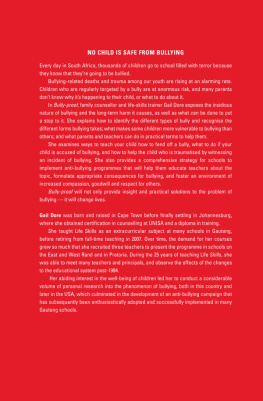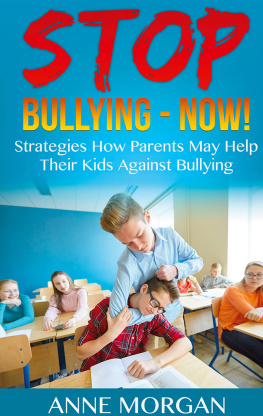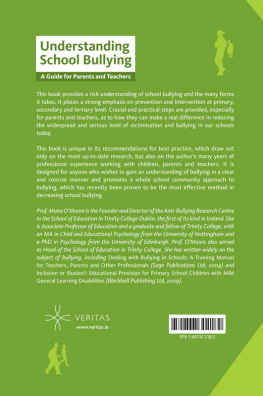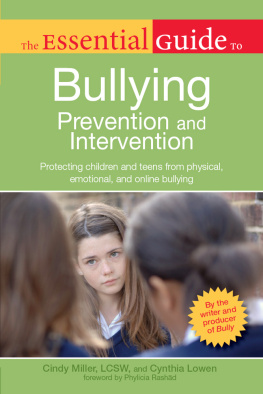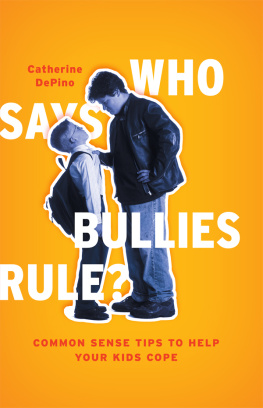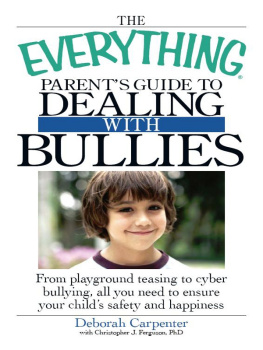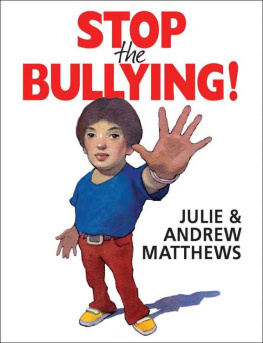
CONTENTS
INTRODUCTION
Every day in South Africa, thousands of children dread going to school, because they know they are going to be bullied. Many others will fake illness in an attempt to avoid the picking-on, name-calling, exclusion or physical abuse that has become their daily torture.
Bullying is not a new phenomenon. Its been with us since the dawn of recorded history, and probably long before then. Many adults choose to shrug it off as being just one of those things, or kids just being kids, while others regard it almost as a rite of passage. Little credence or sympathy is given to the misery suffered by the child who is targeted by a bully, and few understand the devastating long-term effects of bullying. This ill-informed attitude allows bullies to continue their aggression with impunity, and it should come as no surprise that bullying is along with rape one of the most under-reported offences in our country.
In a recent survey, conducted by Pondering Panda, 57 per cent of the schoolchildren questioned reported that they had been bullied. Of these, 52 per cent stated that they had been subjected to verbal bullying that included insults and name-calling, while 26 per cent stated that they were physically bullied as well. These statistics translate into truly frightening numbers, which we ignore at our peril.
It is not only the bullied child who is at risk. Children who engage in bullying are entrenching a set of behaviours that can put them on a collision-course with the criminal justice system. At the very least, they are not learning healthy, productive methods of self-control, coping with conflict, or dealing with diversity. Children who witness an act of bullying are often profoundly affected as well. When an incident of bullying occurs, no one walks away unscathed.
Even though reports of hideous acts of school bullying continue to appear in the headlines, many teachers feel that their hands are tied, either by their lack of knowledge and skill in curtailing aggressive behaviour, or by the strict departmental regulations that limit disciplinary action. Irate parents, frustrated by the lack of meaningful interventions, are often tempted to take matters into their own hands in an attempt to protect their children. While this may be understandable, it invariably makes a bad situation worse.
In Bully-proof, I have endeavoured to address the problem of bullying in a way that does not violate the rights of any individual or break any departmental rules, but at the same time provides a practical guide for those parents and teachers who want to see all South African schools become hurt-free zones.
SCHOOL VIOLENCE AND BULLYING
School-based violence is on the increase in South Africa. Calls from both government and the private sector, insisting that something be done to put a stop to it, are more strident now than at any other time in our nations history.
Bullying is, by far, the most common and pervasive form of school violence. As such, it demands that we give it serious attention. Any environment in which bullying behaviour is tolerated becomes an environment in which violence and aggression flourish.
Although suggestions for the effective management of the other forms of school-based violence laregely lie outside the scope of this book, it should be noted that a well-implemented anti-bullying campaign, as detailed in , will not only significantly reduce incidents of bullying, but will have a positive impact on other forms of school-based violence as well.
of this book, Bully-proofing your child, explores the many forms of bullying, from the subtleties of rumour-mongering to the brutality of physical assault, and takes an in-depth look at how and why bullies behave the way they do. In the school environment, bullies almost never operate alone. Three groups of participants make up what is referred to as the Triangle of Torment bullies in one corner, targets in another, with the onlookers completing the third corner of the triangle.
Children who are regularly targeted by bullies are at enormous risk, both for their present and future well-being. Although adults are mostly aware of this, many parents simply dont know why its happening to their child, or what to do about it. While there is no perfect profile of a victim, there are certain traits and characteristics that will increase a childs risk of becoming a target. These, and more, are discussed in this section. The emphasis is placed on practical steps that an adult can take to help a child avoid becoming the target of a bully; to empower them to stop any bullying currently happening, and to help them recover from the effects of bullying.
Bullies love an audience, and those children who witness an incident of bullying play an important part in either stopping or perpetuating it. Understanding the various roles played by the onlookers puts us in a much stronger position to positively influence their perception, and to channel attitudes in a direction that is not supportive of bullying.
Suggestions are also offered here as to how parents can help if their child is involved in bullying, what to do if a child is being targeted by a bully, and how to help a child who has been distressed by witnessing such events.
of the book, Bully-proofing your school, discusses studies which have shown that the whole school approach to an anti-bullying intervention, which involves learners, teachers and parents, is by far the most effective method of controlling bullying behaviour, and indeed, greatly reduce the risk of future incidents.
An anti-bullying campaign is not merely about changing the behaviour of a few maladjusted children; nor is it about a set of harsh rules or severe consequences. Its about changing the philosophy of the entire school. A well-orchestrated anti-bullying campaign can be an excellent vehicle for facilitating the shift in values and attitudes which are required to foster an environment of increased compassion, goodwill and respect for others. No single group teachers, learners or parents can do this on their own; but by working together and collectively taking a stance against bullying, or any other hurtful behaviour, this important goal can be accomplished.
Thus, of this book provides comprehensive and detailed information on how to create and implement an anti-bullying campaign that incorporates the whole school methodology. It is laid out in the form of a step-by-step approach, from initial surveys to follow-up activities, and allows schools to develop a campaign that is in line with their own unique set of strengths and challenges.
In preparing this book I have drawn from my knowledge and training as a family and relationship counsellor, my twenty-five years of teaching life skills, and from the intensive research done, as well as practical experience gained, in presenting anti-bullying campaigns at many Gauteng schools.
It is my sincere wish that you will not only find the contents of this book informative, but that you will feel motivated to put this knowledge into action. As parents and teachers, merely knowing about bullying is not enough. We need to have the will and the determination to put this knowledge into action, consistently, in order to ensure that our children feel (and are) safe and secure, free to do the best they can at the business of learning.
Lets all join together to stamp out bullying in our schools.
DEFINITION OF TERMS
Child: The word child is used in the generic sense, as a descriptor of young people of school-going age. The terms adolescent and pre-teen are used to denote specific age groups where necessary.
Next page
